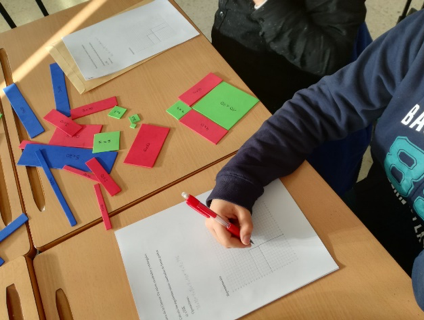- About MAA
- Membership
- MAA Publications
- Periodicals
- Blogs
- MAA Book Series
- MAA Press (an imprint of the AMS)
- MAA Notes
- MAA Reviews
- Mathematical Communication
- Information for Libraries
- Author Resources
- Advertise with MAA
- Meetings
- Competitions
- Programs
- Communities
- MAA Sections
- SIGMAA
- MAA Connect
- Students
- MAA Awards
- Awards Booklets
- Writing Awards
- Teaching Awards
- Service Awards
- Research Awards
- Lecture Awards
- Putnam Competition Individual and Team Winners
- D. E. Shaw Group AMC 8 Awards & Certificates
- Maryam Mirzakhani AMC 10 A Awards & Certificates
- Two Sigma AMC 10 B Awards & Certificates
- Jane Street AMC 12 A Awards & Certificates
- Akamai AMC 12 B Awards & Certificates
- High School Teachers
- News
You are here
On Squares, Rectangles, and Square Roots - The classroom experience
We introduced the historical method for computing square roots described in the preceding section, implemented with the help of manipulatives, to children in their last year of primary school during the 2017-2018 academic year. The participants were 67 sixth-grade primary education students (11-12 years old) in a public urban primary school in Granada (Spain). The students were divided into three groups of 22, 23, and 24 children. For each of the three groups, the experiment was held during a one-hour class session as part of the “Sciences Week Project” developed in the school.
The researcher brought to the classroom rectangles and squares of different colors and sizes made of EVA foam. Students would use these rectangles and squares to “open the square” of a given area. Students were provided with several squares of sizes 1x1, 2x2, 3x3, 4x4, ..., 10x10, and 20x20, as well as different rectangles of sizes 1x10, 2x10, 3x10, ..., 7x10, and 1x20, 2x20, 3x20, ..., 7x20 (all measures are in centimeters).
At the beginning of each session (one for each classroom group) the researcher asked the students what they knew about square roots. They recalled that “the square root of a number is the inverse operation of squaring that number” and that “the square root of a number is another number that when multiplied by itself will equal the initial number”.

Figure 4a. Kai Fang in the classroom: A group of students computes the square root of 196.
The researcher used, as a first example of the Kai Fang construction from the Nine Chapters, the computation of the square root of 144; some students knew the value of this square root. To illustrate the example, the researcher represented 144 as the area of a square on the blackboard. Inside this square, and sharing the same lower left vertex, she depicted a new square with sides of length 10. At this point, she explained to the students that the area not covered with this new square should be filled with two rectangles of the same size and a new square. These rectangles were placed, one above the square of area 100 and the other to its right, having a side in common with this square. This left a new square, smaller in size, at the upper right corner of the original square, to be covered. The side length of this new square was determined by the smallest side of the two rectangles; namely, 2. While the whole representation of the decomposition of the bigger square into two squares and two rectangles was performed, the decomposition of 144 as the sum of the corresponding areas was written on the blackboard.
As the researcher worked on the blackboard, the students reproduced the construction with the manipulative materials at their desks. Once the construction was completed, the length of the side of the square of area 144 was determined as the sum of the length of the largest side of the rectangles (and thus of the length of the square of area 100) and of the length of the side of the square with area equal to 4, yielding 10 + 2 = 12. The result was identified with the operations previously performed on the blackboard. When the students used the method and materials to compute the square roots of 169 and 225, they acknowledged the need to start with the largest possible square (the one of size 10 by 10), and then discussed which rectangles and which square they would need to complete their squares.
Next, the students started to work with the manipulative materials in groups of four. At the same time, the researcher reproduced on the blackboard the Kai Fang constructions of the square roots of 169 and 225, considering all the tries performed by some of the groups before getting the solution. As they worked, the students summoned the researcher or one of the two assistant teachers if they had any doubts, or to confirm that their answer was right.

Figure 4b. Kai Fang in the classroom: A group of students computes the square root of 486.
Next, we gave the students a questionnaire that asked them to obtain the square roots of four numbers:
(a) \(\sqrt{196},\) (b) \(\sqrt{484},\) (c) \(\sqrt{256},\) and (d) \(\sqrt{576}.\)
They were told to use the manipulative materials in order to, for each item, choose from among the different pieces those that they needed to complete the square with area equal to the number for which they must obtain the square root. The students were simultaneously
- completing the tasks with the manipulatives,
- transcribing the operations used for the decomposition, and
- drawing the geometric construction on a grid with numbered axes.
This information was filled in on a form provided for this purpose. We describe the children's results and our conclusions in the next sections of this article.
María Burgos (University of Granada, Spain) and Pablo Beltrán-Pellicer (University of Zaragoza, Spain), "On Squares, Rectangles, and Square Roots - The classroom experience," Convergence (December 2018)




